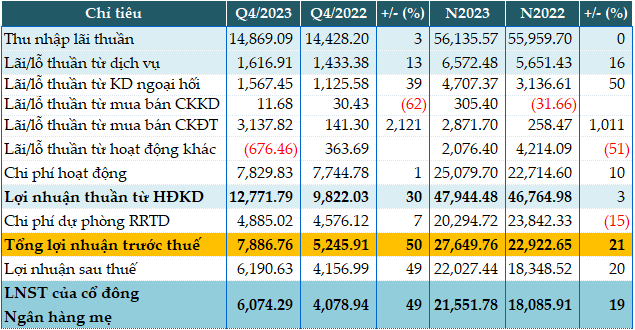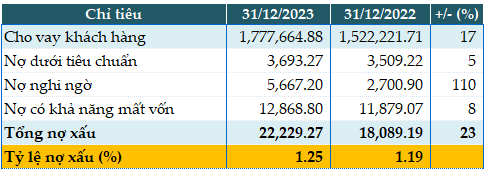Overall in 2023, the core activities of the Bank remained stable with a net interest income of 56.136 trillion VND.
Meanwhile, non-interest income saw strong growth compared to the previous year. Service income increased by 16% (6.572 trillion VND), and foreign exchange trading income increased by 50% (4.707 trillion VND).
Notably, the securities trading activity generated a profit of 305 billion VND, compared to a loss in the previous year. The profit from securities investment trading significantly increased to 2.871 trillion VND, compared to only 258 billion VND in the previous year.
In addition, BIDV reduced credit risk provisions by 15%, only reserving 20.294 trillion VND. As a result, the Bank’s pre-tax profit in 2023 reached nearly 27.649 trillion VND, an increase of 21%.
|
Q4 and full-year 2023 business results of BIDV. Unit: billion VND
Source: VietstockFinance
|
By the end of 2023, the total assets exceeded 2.3 million trillion VND, an 8% increase compared to the beginning of the year. Customer loans increased by 17% (almost 1.78 million trillion VND), and customer deposits increased by 16% (over 1.7 million trillion VND).
As of December 31, 2023, the total non-performing loans recorded more than 22.229 trillion VND, a 23% increase compared to the beginning of the year. Of which, doubtful debts saw the largest increase. As a result, the NPL ratio increased from 1.19% at the beginning of the year to 1.25%.
|
The loan quality of BIDV as of December 31, 2023. Unit: billion VND
Source: VietstockFinance
|







![[Photo Essay]: Experts, Managers, and Businesses Unite to Forge a Path Towards Sustainable Green Industry](https://xe.today/wp-content/uploads/2025/07/z678592918-150x150.jpg)


![[Photo Essay]: Experts, Managers, and Businesses Unite to Forge a Path Towards Sustainable Green Industry](https://xe.today/wp-content/uploads/2025/07/z678592918-100x70.jpg)






